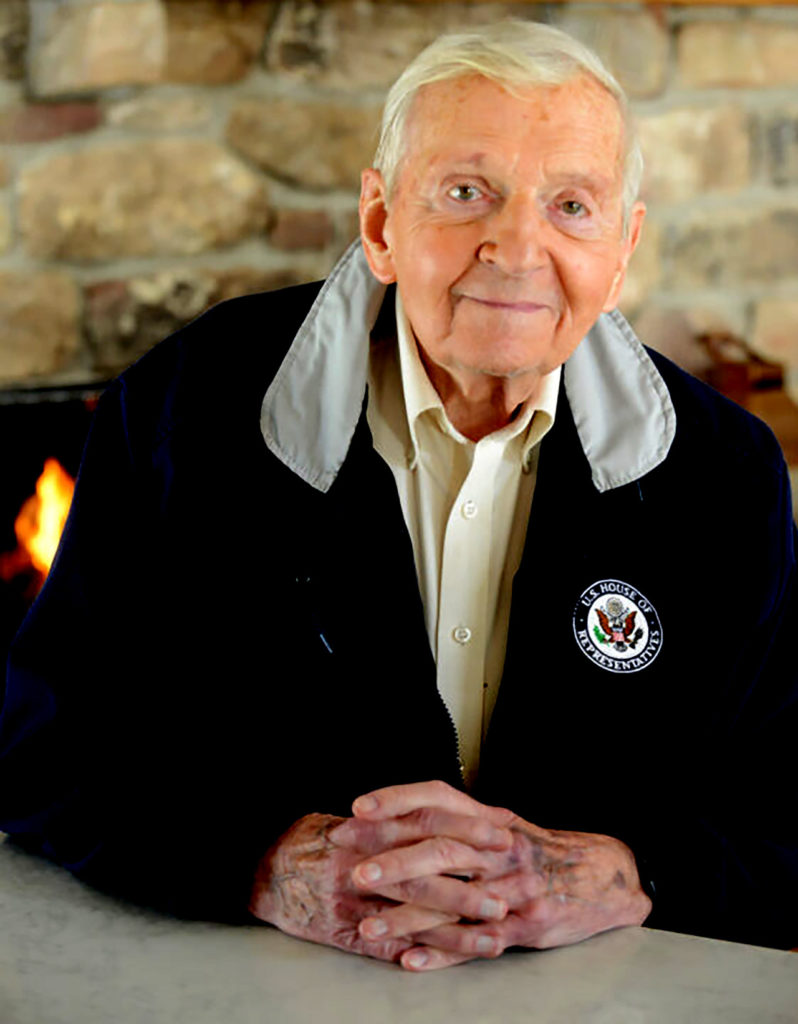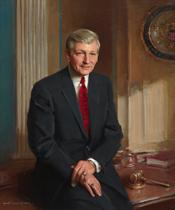
RIP Bud Shuster: A Railroad Friend, Indeed
Written by Frank N. Wilner, Capitol Hill Contributing Editor
Bud Shuster
Former Rep. Elmer Greinert (Bud) Shuster (R-Pa.), who served in Congress as a House member for almost 30 years, and who is best remembered for his leadership of the Transportation and Infrastructure (T&I) Committee, died April 19. He was 91.
Although Shuster retired from Congress in 2001, his constituents voted his son, William F. (Bill) Shuster, a Pennsylvania car salesman, to succeed him—and for eight successive two-year terms. House Republicans graced Bill, from 2013 to 2019, with the same crucial (to railroads) committee chairmanship as his father, who had become a rail lobbyist. Bill resigned his seat in 2019 also to become a lobbyist. Bud and Bill proved extraordinarily helpful to the freight railroad legislative agenda.
As for Bud Shuster, the current crop of congressional leaders could learn much by studying and embracing the Shuster style of bipartisanship that served Bud well in victoriously moving high-dollar transportation authorizations through the House and fending off captive shipper attempts to dial back rail regulatory freedoms he had helped to advance during his earlier years in Congress.

Shuster’s mastery of trading “earmarks” (specified funding for specific projects in designated congressional districts) for majority votes on a variety of issues earned Shuster the title “King of Asphalt.” After, for example, successfully superintending through the House a $218 billion highway construction measure in 1998—some $9 billion of the authorization being earmarks to nudge “yes” votes from others (and, of course, including a $110 million earmark for his own congressional district)—Shuster defended them as the currency of successful legislative leadership. Standing beside the committee’s senior Democrat, James L. Oberstar of Minnesota, Shuster offered, with Oberstar in accord, that designating for earmarks just 5% of an authorization’s price tag was a small levy to gain majority approval.
Shuster had a long and especially consequential relationship with freight railroads, beginning in the late 1970s while serving with Oberstar as a member of the congressionally created National Transportation Policy Study Commission (NTPSC) to examine transportation needs and resources.
Recommended by the NTPSC was liberalizing rail rate regulation, easing limitations on rail line abandonments, and imposing full cost-recovery user charges on rail competitive barges and trucks operating on publicly provided and maintained inland waterways and highways.
Noteworthy and consequential professional bonds would be forged among NTPSC members and staff, who included future Association of American Railroads (AAR) President Edward R. Hamberger, future Federal Railroad Administrator Gilbert E. Carmichael, and future STB member Frank Mulvey, who first would be hired by Oberstar to advise T&I Democrats on rail issues.

Upon Shuster’s 1995 elevation by House Republicans to chair the T&I Committee, a politically astute Hamberger, then a lobbyist and not yet AAR president, volunteered to be secretary-treasurer of a Bud Shuster Portrait Committee, headed by Ann M. Eppard, Shuster’s long-time confidant, chief of staff, political campaign treasurer and fundraiser. The committee raised some $85,000 in contributions toward an oil-on-canvas likeness of Shuster to be displayed in the T&I Committee’s Rayburn House Office Building hearing room.
Eppard proceeded to resign from Shuster’s staff to open her own immediately lucrative lobbying office, attracting as clients Conrail and Union Pacific, and partnering with the lobbying/law firm then employing Hamberger.
Scandal soon enveloped Eppard and Shuster, but not to the detriment of railroads. Eppard was indicted in 1998 on federal bribery and corruption charges relating to a $12 billion Boston highway construction project, as well as misuse of Shuster political campaign contributions. (In 1999, the felony charges were dropped and Eppard pleaded guilty to a misdemeanor charge of “giving and receiving compensation other than authorized by law,” as reported by the Associated Press. She was fined $5,000.)
Then, in what the Oct. 6, 2000 Washington Post termed “an unusually stinging rebuke,” the House Committee on Standards of Official Conduct accused Shuster of bringing “discredit to the House of Representatives” by maintaining “close ties to a lobbyist [Eppard], accepting improper gifts and potentially misusing campaign funds.” Shuster later admitted to five House ethics rules violations and was issued a “Letter of Reproval” by the ethics panel. Shuster said he accepted the ethics committee’s findings only “to stop the hemorrhaging of legal fees and to put this behind us.”
Although re-elected in November 2000 to a 15th House term, Shuster resigned from Congress in January 2001, saying Republican-imposed term limits on House committee chairpersons had more to do with his resignation than the Letter of Reproval. The AAR, where Hamberger had landed as President in 1998, subsequently hired Shuster as a congressional lobbyist reporting to Hamberger.
Eppard also was involved in Shuster’s congressional ethics troubles. Although federal law barred her from lobbying Congress for 12 months following her departure from Shuster’s staff, the House ethics investigation alleged Eppard had “arranged for meetings between [then-Rep.] Shuster and her new clients,” including Conrail.
One of those meetings, according to the ethics panel’s 147-page report, included a private dinner attended by Shuster, Eppard, Conrail President David M. LeVan, and Conrail lobbyist William B. Newman. Eppard, said the report, was being paid $15,000 monthly by Conrail, with Newman testifying that her role was to improve Conrail’s relationship with Shuster. There was no finding that Eppard’s clients received inappropriate legislative benefits, and Eppard was not charged.
Notably, Shuster’s support then was crucial to the railroad lobbying effort in heading off rail captive shipper attempts to dilute partial economic regulation provided by the 1980 Staggers Rail Act. When the Clinton Administration in 1999 sent a shipper-friendly bill to T&I Chairperson Shuster for introduction on its behalf, Shuster was quoted, “Instead of promoting the capital flow that will benefit both railroads and shippers through improved infrastructure, the Administration has sent to the Congress a bill that includes major portions of the [shippers’] reregulation agenda.”
Shuster also was pivotal in creation of the Surface Transportation Board in 1995, warning of “regulatory chaos” were STB predecessor Interstate Commerce Commission simply shut down by Congress as proposed by other lawmakers. Shuster advanced, beginning with successful passage by his T&I Committee, of what would become the ICC Termination Act of 1995 to create the STB and retain much of the ICC’s regulatory mission. Shuster strenuously opposed, as part of STB’s creation, to transfer rail merger authority to the Justice Department, which would soon assail a merger application of Union Pacific and Southern Pacific. In 1996, the recently created STB ignored Justice Department opposition and approved the merger.
One notable member of Bud Shuster’s Republican T&I staff was Roger Nober, who was nominated to the STB by President George W. Bush in 2002, and Senate-confirmed at age 38. Nober, subsequent to his 2006 STB term expiration, became BNSF’s chief legal officer. He retired from BNSF in 2022.
During the time Bud Shuster was lobbying for the AAR and Bill Shuster was in Congress, President George W. Bush nominated Oberstar aide Mulvey to the STB, to which the Senate confirmed him in 2004. Mulvey departed the STB upon his second term’s expiration in 2013 and has since provided consulting services to Norfolk Southern.
Hamberger retired from the AAR in 2019 and subsequently was elected a member of Canadian Pacific’s Board of Directors.

Frank N. Wilner is Railway Age’s Capitol Hill Contributing Editor. His half-century railroad career has included posts as Assistant Vice President of Policy at the AAR and as an STB Chief of Ctaff. His latest book, “Railroads & Economic Regulation,” will be published by Railway Age sister company Simmons-Boardman Books later this spring.



